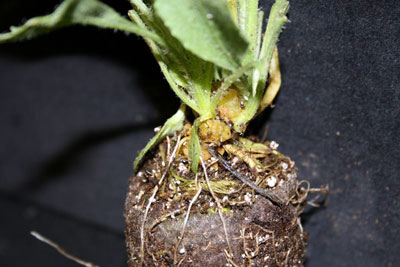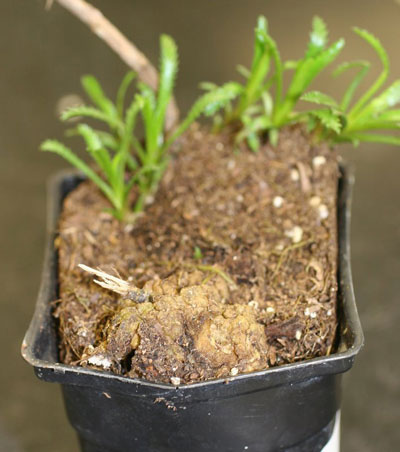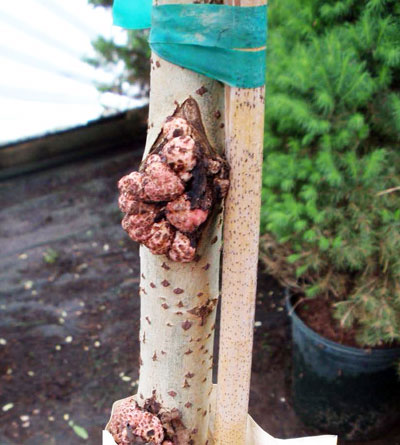Crown gall is a disease of both woody ornamentals and herbaceous perennials
Nursery and greenhouse growers of woody ornamental shrubs, vines, shade trees, fruit trees and herbaceous perennials need to watch for crown gall and take action to eliminate it from their plant material.
Agrobacterium tumefaciens is the bacterial pathogen that causes crown gall. Crown gall is well-known as a disease of woody ornamentals and tree fruits, but it can also affect herbaceous perennials (Photos 1 and 2). The bacterium typically induces plants to produce an abnormally large number of cells that make up the gall. Galls range from pea-size to larger than 1 foot in diameter and are produced on roots, stems and foliage.

Small, succulent galls on a young Gaillardia plant.

Large woody gall on an older yarrow plant.
Agrobacterium tumefaciens is soil borne and can survive in soil without a host for several years. The bacterium enters plants through wounds, often those made by cultural practices such as grafting, pruning or taking cuttings. Once inside the host plant, it induces gall formation. Larger galls may destroy vascular tissue of the plant, causing dieback or plant death. With time, gall tissue breaks down, releasing A. tumefaciens back into the soil or onto other host material.
Good sanitation is an important component of crown gall disease control. Equipment used to prune plants or to take cuttings should be thoroughly disinfested. Symptomatic plants should be removed and destroyed. Greenhouse or nursery plants that are in close proximity to those with galls should also be removed and destroyed; these may be infected, although they are not yet showing symptoms.
Nursery growers need to check incoming plant and tree roots for crown gall disease prior to potting them up for the disease caused by Agrobacterium tumefaciens which causes the galls in many ornamentals, fruit and nut tree species. Another strain called biovar 3 causes crown gall disease in grapevines, also known as Agrobacterium vitis. If you detect the crown gall in planting stock you brought in from another nursery, report the incident to the nursery that provided the liners or whips. Infected plants or trees having tumor-like swellings called galls on the crown of the plant just above the soil (Photo 3). Crown gall disease does not usually seriously harm older plants; however, it may reduce the value of a plant in a nursery. It will render the plants un-saleable by the Michigan Department of Agriculture and Rural Development plant inspectors.

Crown gall on Salix tree. Photo credit: Keith Eldred, MDARD
Plants or tree roots can be dipped in Agrobacterium radiobacter isolate K-1026 (commercial product known as NOGALL) to suppress crown gall caused by Agrobacterium tumafaciens. Applications are made to roots and stems to non-bearing almonds, pecans, apricost, caneberries, cherries, nectarines, peaches, plums, prunes, walnuts and woody ornamentals such as euonymus and roses to name a few plants.
A very good start would be to use a biological control agent like Agrobacterium radiobacter strain 84, i.e., another bacteria that would occupy the same sites and compete for the same food as pathogenic Agrobacterium tumefaciens. Agrobacterium radiobacter k84 releases a protein that inhibits growth of A. tumefaciens. Before planting, roots should be either dipped in or sprayed by water solution containing Agrobacterium radiobacter k84. Spraying is much more economical. One of the trade names that is available is Galltrol. Since this is a living organism, it must be refrigerated until the time it will be used.
Remember, treatment with these products is not a cure, but a prevention strategy for nursery growers. Copper-based fungicides can be used to help limit spread, but again these will not eradicate current infections.



 Print
Print Email
Email




